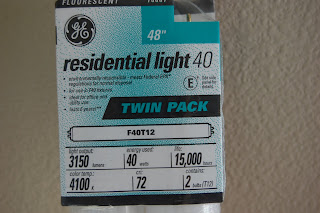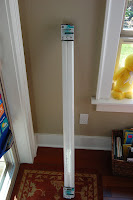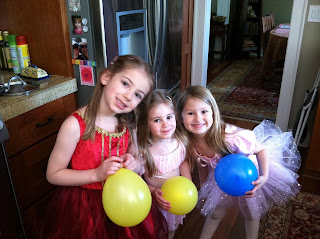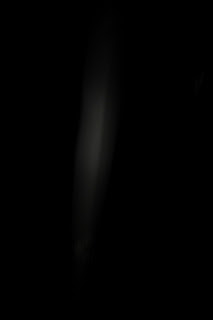This morning is our first day back to school after Spring Break, which has meant slipping back into our routines. I was reflecting this morning over how little reading we did over the break, compared to our normal reading days. It wasn't that we didn't do any reading, just not very much of it. Which got me thinking... perhaps the only way we really ever have time to do anything is if we MAKE time to do it. After all, isn't that what a routine is? Blocks of scheduled times strung together in a predictable pattern?
Ellie Raises A Reader
One Mom's daily account of her family's reading life.
Monday, April 2, 2012
Sunday, April 1, 2012
Library Day #3
We’re back!
Spring break is coming to a close for us and we are spending today
getting ready for the transition back into our usual school day routines. We had so much fun this week and have lots of
reading to share with you. Let’s start
with yesterday’s quick trip to the library, shall we?
Honey, Honey – Lion! By Jan Brett
This Place I Know: Poems of Comfort edited by Georgia Heard
I Got Two Dogs by John Lithgow
My Pumpkin by Julia Noonan
Oh The Things You Can Do That Are Good For You by Tish Rabe
Zero by Kathryn Otoshi
The Story About Ping by Marjorie Flack
The Three Little Pigs We Both Read
Air is All Around You by Franklyn Branley
This Place I Know: Poems of Comfort edited by Georgia Heard
I Got Two Dogs by John Lithgow
My Pumpkin by Julia Noonan
Oh The Things You Can Do That Are Good For You by Tish Rabe
Zero by Kathryn Otoshi
The Story About Ping by Marjorie Flack
The Three Little Pigs We Both Read
Air is All Around You by Franklyn Branley
Thursday, March 29, 2012
Deal Me In
Programming
Note: We will be headed out of town for a bit a spring break fun, so I will not
post tomorrow. See you Saturday!
Yesterday I posted about the board games that we are using to stave off boredom over our
rainy spring break stay-cation. In today’s post I want to share with you
some of Kindergarten Kiddos favorite card games.
First
up: Old Maid
For
some reason this card game never fails to delight Kiddo.
Next
at bat: Go Fish
Another
classic game that I remember from my own childhood.
Last,
but not least: Crazy Eights
All of
these card games (and yesterday’s board games) are perfect for the 4-6 year old
set for a few key reasons:
- They require little or no reading
- The rules are easy to learn and to follow
- They are games of chance, requiring almost no strategy, meaning your Kiddo can beat your socks off fair and square.
A word
about chance: One of the great lessons I’ve learned in life is the lesson
of letting kids lose.
A few
years ago I was playing a card game with my highly competitive niece (then
about 5 years old) and her grandmother. Luck was not on my niece’s side
that evening, and as the game drew towards its inevitable end, my niece grew
more and more distressed (read: maudlin) over the fact that she was going to lose.
I
started manipulating the game so that the odds would be in my niece’s favor and
was annoyed when I realized that her grandmother was not; instead, she
continued calmly playing her cards until she delivered the final, devastating
blow.
While
my niece melted into histrionics over the game, her grandmother gently stroked
her back and said, calmly but firmly,
“I know you're disappointed, but you
don’t always get to win. Some things are out of our control and you have
to play the cards you’ve been dealt, even if they’re not the cards you
want.”
Wow.
She was right. I’ve never forgotten that card game and the urge I had to
“rescue” my niece from the uncomfortable feeling of losing. But at what
cost?
See, I
think that this is where games, like books, let us experience (in a small way)
the bigger emotions of life. We feel the thrill of victory, the agony of
defeat, the heady pleasures of luck, and the bitterness of having to play out a
bad hand.
Who knew so much
could happen during a simple card game?
Wednesday, March 28, 2012
Hungry and Bored Games
Well friends, here at our house Kindergarten
Kiddo is on Spring Break, which means that there are a lot of hours in the day
to fill. As an only child, Kiddo has had
plenty of practice in the art of occupying herself, but as the days at home
stretch on, she inevitably turns to one of the grown-ups in the house for
entertainment.
Being that we live in the Pacific Northwest,
naturally the weather has been perfectly miserable: cold, wet, and unrelenting
rain has been falling all day and shows no signs of letting up for
the remainder of the week. We’re
starting to run out of ideas. I’m
wondering if you are too, so I thought that in today’s post I’d share with you some
of the board games we’ve been playing this week.
Side note: Kiddo has outgrown the likes of "Chutes and Ladders", and "Candyland", but these are good to start with if your Kiddo is new to board games.
First up: "Sorry" by Hasbro
This classic board game is perfect for young
players because it requires only basic counting skills (the highest number card
is 12) and minimal reading. The rules of
Sorry are about as easy as they come - they are almost intuitive.
Even if your Kiddo isn’t reading yet, if she has played the game enough she
will likely have memorized that the 4 card means move 4 spots backward, or that
the sorry card means you get to bump your opponent back to start.
Bonus Points: Depending on your Kiddo’s level
and interest, you can play the game with only one pawn per player or all four,
thus making the game easier (and shorter) or more challenging. Besides, it’s a fun game for grown-ups and
Kiddos alike.
Next up: "Sum Swamp" by Learning Resource
This is probably Kindergarten Kiddo’s
favorite board game right now. This game
comes with a game board, two six-sided die numbered 1-6, a four-sided
operations die (+ and -) and four figurines. I cannot
tell you how much fun Kiddo is having with this simple little game. Seriously, I keep thinking: why didn’t I come
up with this sooner?
Bonus Points: This game reinforces not only
simple addition and subtraction, but also the concepts of zero, even, and odd.
Tuesday, March 27, 2012
Science Saturday #3
Okay, so technically it’s Tuesday, but I
promise you: this is a science post worth waiting for!
This week’s experiment: Make Your Own Ghost
(aka: how to make a light bulb glow without plugging it in)
(aka: how to make a light bulb glow without plugging it in)
The purpose of this experiment is to
illustrate how we can generate electricity with our own bodies that can be used
to make a fluorescent light tube glow.
Stuff
you need:
Latex balloons
Long fluorescent light tubes
A dark room (we used a storage closet and a
bathroom with no windows)
Curious Kiddos (costumes optional) pictured l-r, Kiddo JPO, Kiddo LPO, Kindergarten Kiddo)
We began this experiment by asking our Kiddos
to predict how we could make the light tube glow without plugging it in to a
socket. Our Kiddos guessed, “You can
make it glow with the sun.” And then…
“You can use static electricity!” Bingo.
This experience will be a lot more
interesting for your Kiddo if you spend some time building up his or her
background knowledge a bit. Keeping in
mind that this is an experiment for Kindergarteners (and one 3 year old
sibling), we kept our overview pretty basic.
First, talk with your Kiddo about how light
is a form of energy. This is a concept
that even very young children can grasp onto.
Next, explain that the fluorescent tube is coated inside with a special
chemical (phosphorous powder) that is turned on (glows) when it comes in
contact with energy. Describe how you
are going to use the balloon to create the kind of energy that the light tube
needs to glow. Finally, explain that in
order to see the light tube glow, you must conduct your experiment in a very
dark space.
Step One: Inflate and tie the balloon.
Step two:
Find a Dark room where you can shut out most incoming light. We used a closet, but a dark, windowless
interior room would work too.
You can try to do this under a very heavy blanket if your Kiddo gets too
scared of, say, being stuck in a small dark room; just be sure that all ambient
light is shut out.
Step Three: Place one end of the tube on the
floor and hold it upright. We
found it easier for the grown-ups to handle this part of the experiment. We also found that if you are working on non-carpeted surfaces, it works best if the grown-up holding the tube is also wearing socks
and can rest one end of the tube on the top of her toes.
Step Four: Rub the balloon up and down the
side of the tube as fast as you can.
Within seconds the tube will start glowing.
Here are two pictures that we managed to get
of the glow.
Don’t they look like ghosts?
Extra Credit: If your Kiddo is older (or a
genius) you can spend some time explaining about the ultraviolet light that
melts the drop of mercury inside the tube which turns into a vapor laden with
electrons that then interacts with the phosphorous powder coating the inside of
the tube. This is explained in detail in
Janis VanCleave’s book Physics for Every Kid, the book we used for this
experiment.
VanCleave’s book says, “Once the tube
starts glowing, even the nearness of the balloon causes light to be
produced.” We weren’t able to reproduce
this result, but honestly – who cares?
This experiment’s results were neat enough on their own.
Cost for this experiment: the two pack of light tubes was $5.99 and the balloons were $2.
A big THANKS to Momma K and Kiddos J&L for experimenting with us today!
A big THANKS to Momma K and Kiddos J&L for experimenting with us today!
P.S. Getting the photo of the glow was a bit
tricky. If you want to know how we did
it, leave a comment and I’ll reply – otherwise, the post gets too long.
Monday, March 26, 2012
Raising a Writer Too #2
Last night we had our good friends Ruth & Jim over to
our place for dinner. Kindergarten Kiddo
spent the better part of the afternoon performing her duties as the table
setter. This is a job that she takes
very seriously, especially when we are expecting company.
After carefully arranging silverware and napkin rings and placing the water glasses just so, Kiddo decided something was missing: hand-lettered menus. Now, normally we like to keep it pretty casual around here, but occasionally Kindergarten Kiddo likes to channel her inner Fancy Nancy.
Here’s what she came up with:
Creating menus is a great way for your Kiddo to practice his or her writing. Kindergarten Kiddo makes menus a lot at our house. It’s a great way to keep her busy and engaged while I put the finishing touches on (okay – throw together) dinner. Encourage your Kiddo to try to spell the menu items on his or her own, or, if it is a special occasion, write them on a separate piece of paper that your Kiddo can refer to. It’s also fun to have your Kiddo illustrate the menu.

After carefully arranging silverware and napkin rings and placing the water glasses just so, Kiddo decided something was missing: hand-lettered menus. Now, normally we like to keep it pretty casual around here, but occasionally Kindergarten Kiddo likes to channel her inner Fancy Nancy.
Here’s what she came up with:
After finishing her first menu, she felt it would be prudent
to make menus for each guest to enjoy.
Creating menus is a great way for your Kiddo to practice his or her writing. Kindergarten Kiddo makes menus a lot at our house. It’s a great way to keep her busy and engaged while I put the finishing touches on (okay – throw together) dinner. Encourage your Kiddo to try to spell the menu items on his or her own, or, if it is a special occasion, write them on a separate piece of paper that your Kiddo can refer to. It’s also fun to have your Kiddo illustrate the menu.

Sunday, March 25, 2012
One Hit Wonders #1
I was born smack dab in the middle of the 1970’s and grew up
as a child of the 1980’s. I’m sure that
many of you reading this right now are conjuring up favorite books from your
80’s childhood – something by Shel Silverstein, perhaps…
…or maybe Judy Blume.
Well, not me. All of
the books that I remember best from childhood were written in the 1960’s. Why? During my childhood, my mother was, as she
liked to refer to herself, a “garage-saler”.
You read that right – garage s-a-l-e-r.
Trust me when I tell you that there wasn’t a single Saturday of my
childhood that my mother did not hit at least three garage sales.
While this had somewhat tragic results for my and my
sibling’s trousseau, it did mean that over a childhood of
summer Saturdays, we amassed a rather obscure book collection. These were not popular series books, or
Disney spinoffs. These were the
One-Hit-Wonders of the children’s publishing world.
The first one I’d like to share with you is the Teeny Teeny
Tiny Giraffe.
Teeny Teeny Tiny Giraffe is a Rand McNally Junior Elf book.
These tiny tomes measure just 4.5 in wide and 6.5 in
long. They fit perfectly into children’s
hands and were sold for the retail price of .49 cents! I loved this book because of the rich illustrations. I don’t recall ever actually reading the
words in this book, and yet it remains an important part of my literary
history.
Which brings me to my point: a
book’s value does not lie solely in its words.
Sometimes you just want to look at the pictures – and that’s ok
too.
Subscribe to:
Posts (Atom)



















